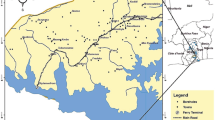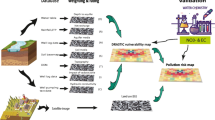Abstract
The east coast of Rio de Janeiro State, Brazil, shows a worrying overlap between areas with intrinsic groundwater vulnerability and the most significant urban expansion zones. It experienced a rapid population growth in recent years, mainly due to the tourism industry, resulting in a significant pressure on drinking groundwater resources. In this regard, development and use of techniques to control and protect areas susceptible to contamination is crucial. The elaboration of aquifer vulnerability maps is thus extremely helpful to support water resources management. The aim of the work is to present the methodological approach in the use of Geoprocessing techniques to obtain a suitable groundwater vulnerability model in Rio de Janeiro east coast. Considering the existing problems and the current land use and characteristics of the study region, it is clear that the most vulnerable areas (that is, “extreme” and “very high” vulnerability areas), coincide with the most significant zones of urban occupation, corresponding to 11% of the total study area, demanding adoption of urgent measures in the near future. Geoprocessing tools and remote sensing for characterization of Rio de Janeiro’s east coast aquifer vulnerability gave good results, representing a satisfactory method for management actions at low cost.




Similar content being viewed by others
References
Adams B, Foster S (1992) Land surface zoning for groundwater protection. J Inst Water Environ Manage 6:312–320
Al-Adamat RAN, Foster IDL, Baban SMJ (2003) Groundwater vulnerability and risk mapping for the basaltic aquifer of the Azraq basin of Jordan using GIS, Remote Sensing and DRASTIC. Appl Geogr 23:303–324. doi:10.1016/j.apgeog.2003.08.007
Aller L, Bennet T, Leher JH, Petty RJ (1987) DRASTIC: a standardized system for evaluating groundwater pollution potential using hydrogeology setting. US Environmental Protection Agency, Report EPA-600/2-87/035
Barros RS, Cruz CBM (2007) Altimetric evaluation of SRTM digital elevation model. Paper presented at XIII Brazilian symposium on remote sensing. Florianópolis, 21–26 April 2007, vol 1, pp 1243–1250 (in Portuguese)
Bidegain P (2002) Araruama Lagoon-environmental profile: world’s greatest hypersaline lagoon ecosystem. In: Bidegain P, Bizerril C (eds) Araruama Lagoon -Rio de Janeiro. SEMADS 1:1–160 (in Portuguese)
Brown LJ (1998) Ground water contamination vulnerability map of Heteranunga plains, Hawkes Bay. Institute of Geological and Nuclear Sciences Client Report-92769D
Civita M, Forti O, Marini P, Micheli L, Piccini L, Pranzini G (1990) Aquifer vulnerability to pollution in Alpi Apuane. Mem explic Monography GNDCI 399:1–56 (in Italian)
CPRM-Brazilian Geological Survey (2001) Rio de Janeiro State geology. Silva LC, Cunha HCS (eds) Basic geological surveys of Brazil (in Portuguese)
Cruz A, Silva Jr GC (2006) Spatial and temporal hydrochemical behavior of Piratininga coastal aquifer, Niterói city, Brazil. Paper presented at the First International Joint Salt Water Intrusion Conference (1st SWIM-SWICA), Chia Laguna, Italy, 24–29 September 2006
Cruz CBM, Vicens RS, Seabra VS, Reis RB, Faber OA, Arnaut PKE, Araújo M (2007) Object oriented classification to map Mata Atlântica rainforest biome remnants, scale 1:250,000. Paper presented at XIII Brazilian Symposium on Remote Sensing. Florianópolis, 21–26 April 2007, vol 1, pp 5691–5698 (in Portuguese)
Foster S, Hirata R (1988) Groundwater pollution risk assessment: a methodology based on available data. CEPIS/PAHO Technical Report. Lima, Peru
Hamerlinck JD, Arneson CS (1998) Wyoming ground water vulnerability assessment handbook, vol 1, Background, model development, and aquifer sensitivity analysis. Laramie, Wyoming: Spatial Data and Visualization Center, University of Wyoming. SDVC Report 98-01-1
Herlinger Jr P, Viero AP (2007) Groundwater vulnerability assessment in coastal plain of Rio Grande do Sul State, Brazil, using drastic and adsorption capacity of soil. Environ Geol 52(5):819–829. doi:10.1007/s00254-006-0518-4
Hoffmann J, Sander P (2007) Remote sensing and GIS in hydrogeology. Hydrogeol J 15:1–3. doi:10.1007/s10040-006-0140-2
Kumar N, Engel BA (1994) GIS in Sattewide groundwater vulnerability evaluation to pollution potential. National conference on environmental problem-solving with geographic information systems, Cincinnati, Ohio
Le Grand H (1964) System for evaluating contamination potential for some waste sites. Am Water Work Assoc J V 56(8):959–974
Muehe D (1982) Distribution and characterization of sandy sediments in internal continental platform between Niterói and Ponta Negra, RJ. Rev Bras Geociências 19(1):25–36 (in Portuguese)
Muehe D (1998) Brazilian seashore and its compartmentation. Cunha, SB & Guerra, AJT (eds). Geomorphology of Brazil. Capítulo 7. Editora Bertrand Brasil S.A. Rio de Janeiro, RJ (in Portuguese)
Richert SE, Young SE, Johnson C (1994) SEEPAGE: a GIS model for ground-water pollution potential. ASAE Paper n° 922592. American Society of Agricultural Engineers International Winter Meeting, Nashville, TN
Ross M, Martel R, Lefebvre R, Parent M, Savard MM (2004) Assessing rock aquifer vulnerability using downward advective times from a 3D model of surface geology: a case study from the St. Lawrence Lowlands, Canada. Geof Int 43(4):591–602
Seabra VS (2007) Geoprocessing tools to evaluate vulnerability in eastern Fluminense coast. MSc, Federal University of Rio de Janeiro, Brazil (in Portuguese)
Silva Jr GC, Lowsby M, Souza MGA, Rocha PF, Monteiro AC, Almeida RR. (2000) Seawater intrusion in coastal aquifers of Rio de Janeiro east coast: Niterói Oceanic Region case study. Paper presented at the 1st Groundwater Integrated World Congress 2000, Fortaleza, Brazil, 31 July–4 August 2000 (in Portuguese)
Silva Jr GC (2002) Groundwater management in Brazilian coastal areas. Paper presented at the XXXII International Association of Hydrogeologists Congress, Mar del Plata, Argentina, 21–25 October 2002
Silva Jr GC, Pizani TC (2003) Vulnerability assessment in coastal aquifers between Niterói and Rio das Ostras, Rio de Janeiro State, Brazil. Rev Lat Am Hidrogeol 3(1):93–99
Stigter TY, Ribeiro L, Carvalho AMM (2006) Evaluation of an intrinsic and a specific vulnerability assessment method in comparison with groundwater salinization and nitrate contamination levels in two agricultural regions in the south of Portugal. Hydrogeol J 14:79–99. doi:10.1007/s10040-004-0396-3
Thirumalaivasan D, Karmegam M, Venugopal K (2003) AHP–Drastic: software for specific aquifer vulnerability assessment using DRASTIC model and GIS. Environ Model Soft 18:645–656. doi:10.1016/S1364-8152(03)00051-3
Turc B, Martin L, Flexor JM, Suguio K, Tasayaco-Ortega L (1999) Origin and evolution of Quaternary coastal plain between Guaratiba and Cabo Frio, State of Rio de Janeiro, Brazil. In: Knoppers BA, Bidione ED Abrão JJ (eds) Environmental geochemistry of the coastal lagoon system of Rio de Janeiro Brazil. Série Geoquímica Ambiental, vol 6, pp 25–46
Tweed SO, Leblanc M, Webb JA, Lubczynski MW (2007) Remote sensing and GIS for mapping groundwater recharge and discharge areas in salinity prone catchments, southeastern Australia. Hydrogeol J 15:75–96. doi:10.1007/s10040-006-0129-x
US Environmental Protection Agency—USEPA (1993) A review of methods for assessing aquifer sensitivity and ground water vulnerability to pesticide contamination. Report EPA-813R93002
Van Stempvoort D, Ewert L, Wassenaar L (1992) AVI: a method for groundwater protection mapping in the Prairie Provinces of Canada. PPWD pilot project, September 1991–March 1992. Groundwater and contaminants project, Environmental Sciences Division, National Hydrology Research Institute
Acknowledgments
The authors wish to thank CAPES - Coordenação de Aperfeiçoamento de Pessoal de Nível Superior for the scholarship of the first author and research support from Brazilian CNPq (Conselho Nacional de Desenvolvimento Científico e Tecnológico) agency for the project. They also wish to thank Mrs. Giovanna Zanoni for the manuscript review.
Author information
Authors and Affiliations
Corresponding author
Rights and permissions
About this article
Cite this article
Seabra, V.S., Silva, G.C.d. & Cruz, C.B.M. The use of geoprocessing to assess vulnerability on the east coast aquifers of Rio de Janeiro State, Brazil. Environ Geol 57, 665–674 (2009). https://doi.org/10.1007/s00254-008-1345-6
Received:
Accepted:
Published:
Issue Date:
DOI: https://doi.org/10.1007/s00254-008-1345-6




